Animation Analysis:
For my animation to be the best it can be, viewing other animated films would support my work by indicating what techniques are used in the already existing film. I will talk about the use of: cinematography, motion, sound effects and editing pacing of other animated films. This would help me understand what areas I need to improve on or add to my animated work.
The Tale Teller:
- Motion
The Tale Teller (2016) is animated by using the parallax technique. The motion of the layers is animated smoothly by using motion tween, which conveys a well blended and fluent motion to characters such as the tale teller. A new frame or layer replaces the previous frame or layer to give the illusion of different body positions such as, when a character is blinking or opening the hand to grab something, a new layer of an open hand is replacing the previous layer which is a closed hand. In my proof of concept, I tried that approach and it went well. However, it looked a bit jarring and choppy when switching layers. Therefore, this has made me realise that I need to add and experiment with motion tween to blend the transition of laters together.
- Cinematography
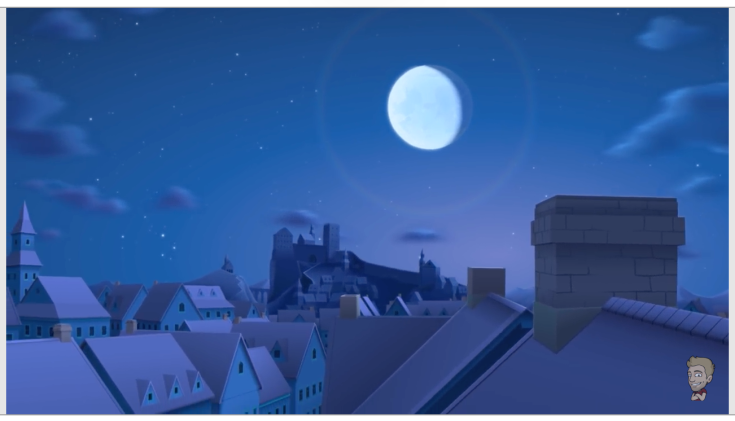
fg.1
This is an establishing shot of the the town. Establishing shots convey where the story or scene is taking place. It adds relevence to the story which informs the audience what environment or area the character is at. If it’s in a city, the audience would expect loud noises and a busy atmosphere due to the expected crowd of people within the city. If it’s in a rural area like a small village, the audience would expect a calm environment and some wild life like birds in the background. Also, for example if the story begins with an establishing shot of a war ground with fire, the audience would expect the next shot showing dead soldiers which brings a sense of tragedy.
The colours of the night sky gives a cold and helpless mood, which is appropriate because at the start, there is footage conveying the tale teller struggling and the narrater gives confirmation to the audience of what is happening on screen. I would like to experiment more with colours in my animated shots because, I believe that would add more of an interesting impact to the audience. Also, I would like to improve the perspectives of my drawn layers/shots. Some shots are decent but I believe they could be better, so I will see what I can do to improve that.
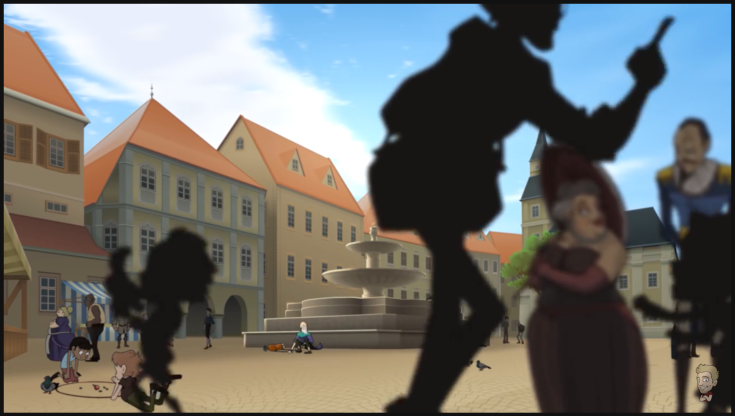
fig.2
This is a rack focus/establishing shot of the tale teller in the middle of the town square. The blurred characters and silhouettes, adds depth to the shot. It indicates the distance between the character and the camera, more clearly to the audience. This is used to show a sense of traffic in the town square, which gives life to the whole shot and the situation our main character is in. In the opening shot of my animated film, I would like to add more depth to the shot which would give the illusion of 3D.
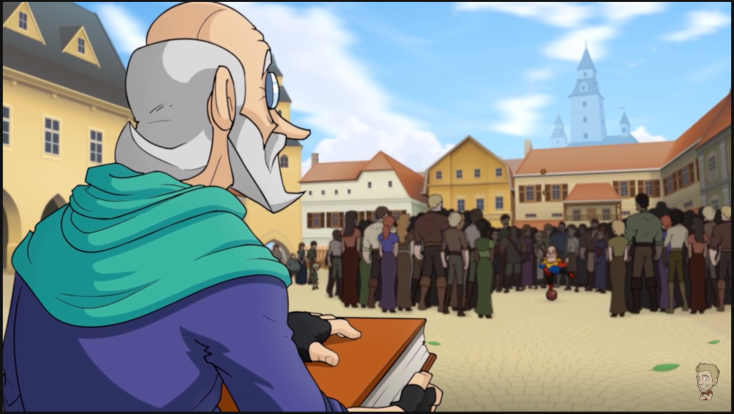
fig.3
This is like an over the shoulder shot. This is also using the rule of thirds, the subject matter which is the main character, is in focus where as the crowd is in the background. This is the sort of shot that I would like to replicate, when the father is looking over to his daughter perming in the town square, attracting an audience. I believe in Adobe After Effects, I can use the blur effect on the timeline to give that rack focus effect.
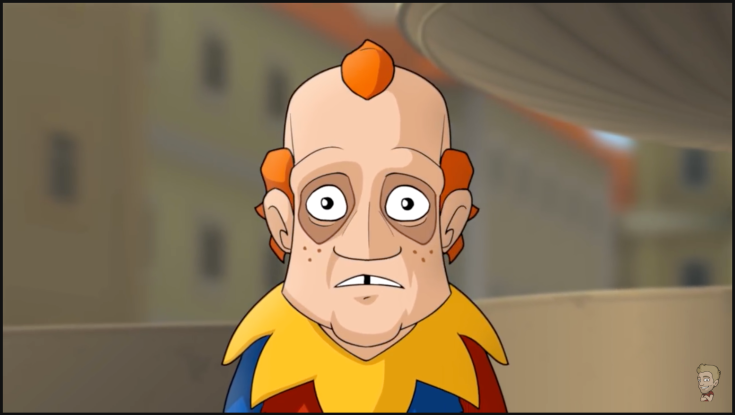
fig.4
This is a medium close up shot of one of the charters in The Tale Teller. This shot is used to conevy a character’s emotion after like an event or the character has a moment of realisation. This shot is used add more of a dramatic impact to the story and audience would also follow and have a sense of realisation or reaction to the character’s change of mood. In Our Dreams, there will be a few of these shots because it tends to amplify the connectivity between the audience and the story/character.
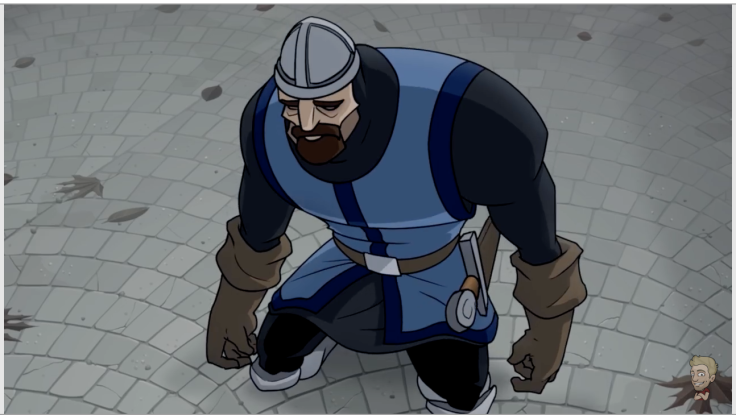
fig.5
This is a high angle shot of the soldier in The Tale Teller. This shot is used to convey a character’s vulnerability or helplessness. This is the opposite of a low angle shot, which is used to convey a character’s power and confidence, basically showing who has the upper hand in a sense. I will use this sort of shot in my animated film, to show the young magian’s lack of support and a sense of being lost.
- Sound Effects/Audio
The Tale Teller has appropriate background music. It matches the mood and setting of each shot. For instance, within the first minute of the animated film, a sad violin plays in the background which gives a sense of a sad mood and adding more of an impact to the audience by informing them that the character is in a sad or lonely situation.
The narrator and the background music together has an overwhelming dramatic impact. The narrator is nice and clear and clearly explains what is happening on screen. It’s like a story book sort of feel to the animation. There won’t a narrator in my animated film but I want the music to match the mood and fill in the atmosphere, that would make the animated film more interesting to the audience.
- Editing Pacing
The editing pacing within The Tale Teller is well executed, especially the part when the action on screen, the sound effects and narrator are all in synced with each other from time 1:24 – 1:27 of the video. Shots that are dragged on for too long loses interest and connectivity from the audience watching. Fast and well paced shots keeps the audience engaged with the story because the audiences likes to look at the world and surroundings the characters are in. Editing is quite crucial because, editing within a film is what makes the story progress and entertaining.
Match on Action
Shot 1
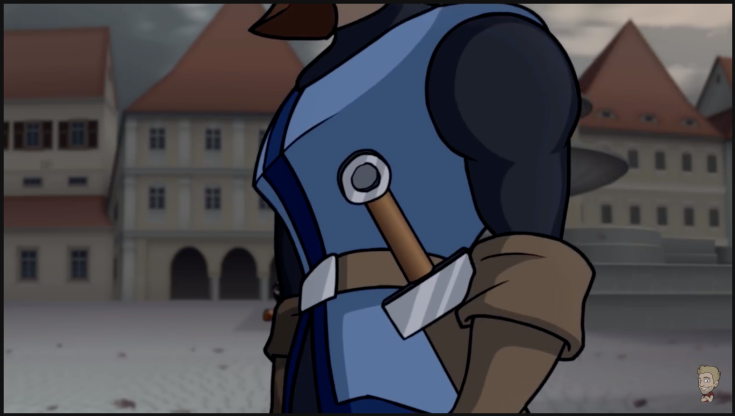
shot 2

Match on action is when an action starts in one shot, and ends in the next shot. For instance, the soldier in The Tale teller is falling on to his knees in one shot and then slouches forward a bit in the next shot. This gives another perspective to what action the character is undertaking and it gives another angle to the audience to view what mood the character is in. Within the proof of concept I included this technique in and it was effective. However, I would like to get better at editing and the pacing of each shot, especially when when it comes to close up shots and match on action shots. So I will practice by creating a few tests for myself which is animating a turn using two shots to create a match on action.
Live Action:
3D Camera:
I want to find out how to make my animation look more 3D to the audience. I want it to feel like the environment is actually there. I know a 3D camera is in Adobe After Effects so I could use that to make my animation look 3D. I will research how to use the 3D camera in Adobe After effects by looking at tutorials online and I access books in the library that is about a 3D camera. The books I will look at is ‘The Visual Effects Arsenal’ and the ‘
Graph Editor:
Graph editor is an advance method of manipulating the speeds of animation on the time line. This could be useful with the parallax technique.
Perspective:
To improve the visual quality of the animated film, I will look at tutorials online such as ‘Easy PERSPECTIVE for beginners HOUSE drawing’ and ‘How to Draw The Figure in Perspective – Foreshortening’. They will convey illustration techniques and how to create perspectives in drawings. To make it seem realistic and proportionally correct.
- Building Perspective
This person coveys the techniques on how to create a 3D house that has a lot of volume. She uses a ruler to draw guide lines to help her get the perspective and proportion correct. For this house illustration, she uses two point perspective, which are guide lines to indicate how it would look from a specific angle. This is really effect

I’ve watched the videos and they seem to use the perspective lines technique, I am interested to give this technique of drawing a try. First, I drawn shapes such as squares and rectangles, in different perspectives. This shows how I normally draw something like a building in a certain perspective. I want to see if I can use a new technique to draw buildings in a more dynamic and proportionally accurate perspective.

I tried using this technique and I can’t seem to get it right, with this attempt I think I have drawn way too many line at random positions. So perhaps if I draw less lines, then it would look a bit better. Also if I draw the lines a bit more strategically, then perhaps it would be a bit more clearer as a guide to me.

This is my second attempt at trying this new technique and this time I drawn less lines. This looks a lot better than my first attempt but I can’t seem to get it right. As you can see the lines don’t line up properly to use as a guide to draw a building. However, it is getting better I will try this again and carefully look at where I’m drawing each line with the ruler that I have been using.

This is my third attempt and I have placed the lines a bit more strategically and trying to visualize the angle of the house. The shape looks better than the last attempt and I can see with a few tries it can be quite useful. However, I might not use this technique all the time because I’m so use to how I usually draw buildings which is free hand. Also drawing free hand would save me a bit more time considering I’m trying to manage to make a 3 minute film but I can see the benefits of this technique.

I tried drawing a room at a perspective that I would normally draw it. As you can see, if there a long object like a bed. The head of the bed would be drawn smaller because it’s the furthest away from the camera. The end of the bed would be larger because it’s the closest to the camera. Fundamentally, whatever object is close to the camera, it would appear larger than objects that is further away from the camera. This would help me improve the animation quality in terms of perspectives when I come to drawing indoor environments such as the pub.
- Character Perspective
- Practical Experiments:
I have followed the two videos asked on character perspective. The first video shows 3 different perspectives. The first one was a front angle perspective, the second is a high angle perspective and the third a complex perspective of a man sitting down. I decided to try and draw the first two perspectives considering they are the sort of perspectives I intend to use. I have drawn the front angle of the man first and then decided to try and draw my magician character in the same perspective. I did the same with the other perspective shot which is drawing the man first and then trying to draw my magician character in the same high angle perspective.
This was good practice considering that I will hopefully use these perspectives within my animated film. This would help compliment the same perspectives of backgrounds, which would give the illusion of a real camera.
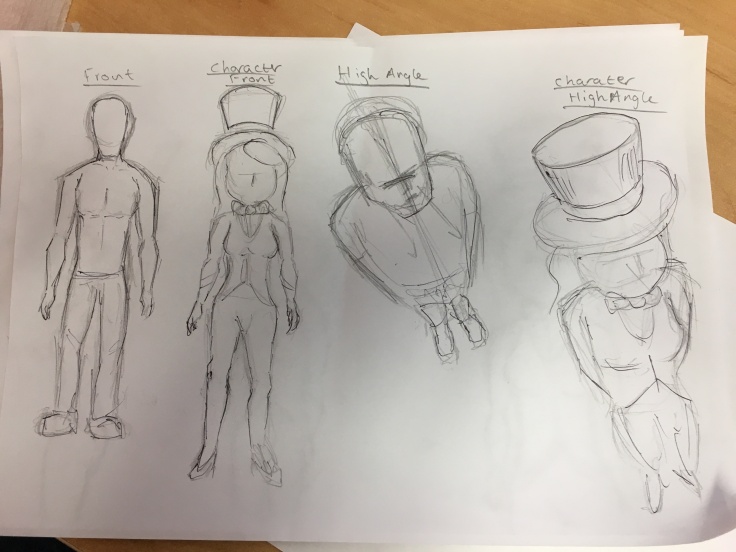
Then I moved onto watching and following the video by Draw With Jazza. He talks about the character turnaround and he conveys how to illustrate the same character but at three different perspectives. I followed what he was doing by drawing my magician character in the same perspectives that Jazza is illustrating his character in. I started off with the side angle perspective, then the 3/4 angle perspective which is believed to be the most dynamic when illustrating characters or real life people, and then I finish by illustrating the front angle. Looking back, I believe the most used angle is the 3/4 angle because I use that quite a few times in my proof of concept and the second most used is the front perspective.

Parallax Technique:
The parallax technique is a method of animating. It uses layers of different illustrations, and those layers move or enlarge too create a 3D illusion. It’s a fast method of creating an animation. Disney uses the parallax technique to make their backgrounds seem realistic in the way that the distance of environments changing. I want to find out how to create the illusion of distance using the parallax technique.
The moon stays the same distance, considering the distance between the earth and the moon.
Copyright Free Music:
My film will require some background music that fits with the whole theme and aesthetic of the animated film. The music should blend in with the film throughout, it would fill out the empty atmosphere. Unfortunately I am not a music making expert, so creating my own background music would be quite a challenge for me and time consuming. However, there is copyright free music online that I can access. The are copyright free music websites such as Freesound (2005), where I can retrieve copyright free sound effects and music samples.
There is another website to gather copyright free music, that website is called Soundcloud (2008). There are music creators that doesn’t mind people using there work for their own benefit, just as long that the music creators are properly credited and referenced. I will search for any potential copyright free music that I could use in my animated film. So I will search on Freesound and Soundcloud for sound effects that is need ed in the film and for background music to fill the atmosphere.
Copyright Law:
Copyright is the law to give owners the right to control how people can use their work like: music, books, pictures, movies and websites. Online, it is said that copyright is valid whilst the owner is still alive, plus a 70 year period of validation to the copyright is added. That is why Shakespeare’s work is distributed by several companies and people because after the copyright has been lifted, anyone is free to share and gain Shakespeare’s work.
Music:
https://incompetech.com/music/royalty-free/index.html?feels%5B%5D=Calming&page=0
Different Microphones and Sound Recording:
I want my animation to have good quality audio, and I need the best microphones for recording sound effects and dialogue, to add to the animation. To find out which microphone is best for recording sound effects and dialogue, I will first look online to see what it says about different microphones. That would give me a good idea which microphones to try out and decide from there, saying what is good and bad about them. I intend to look on Media College, Rode, and Sennheisers websites and conduct one experiments to see which microphones work best.
Which microphone is recommended for recording foley?
Which microphone is best for recording dialogue?
- Unidirectional Microphone
Shotgun mics are directional microphones. They pick up sound from one direction and cancels background noise from other directions. They are often used for recording dialogue or sound effects because, they pick up one sound frequency in direction. However, a Shotgun mic is a super cardioid or cardioid.
I’ve did my research, with the help of this website all about the different types of microphones.
(MediaCollege)
Super Cardioid Cardioid
- Super Cardioid
The super cardioid is used to pick up sound from the direction it’s pointing. However, it can also pick up a bit of sound from the opposite direction. As you can see, there is a small bump sticking out of the super cardioid grid, that’s behind the mic. Which is why, when Foley artist create sound effects, they stand at least a meter away from the desired sound.
If they stand close to the desired sound, the front and also the back of the microphone will pick up the same sound, thus the sound being all distorted and too fuzzy to even use.
- Cardioid
As you can see, a cardioid is like an upside down heart. This microphone has quite a lot of response over 180 degrees in front and has minimum response at the back. The polar curve represents its directional response being a cardioid.
A shotgun mic is great for recording sound effects to use in Foley work. However, I don’t know if it would work well on getting my needing sound effects such as footsteps, high heels for the young magician specifically. Also the surfaces like stone and wood. The only way for me to find out is to bring in some items that I will need to use to Create sounds and record them with the shotgun mic.
- Dialogue/Voice Recording
Condenser Microphone

Condenser microphones are mainly used for recording dialogue from voice actors. They are great for clearly recording dialogue. In animated films such as The Lego Movie (2014), Voice actors spoke into a condenser microphone. Perhaps that’s what professionals use in the industry. If so, I would like to try out this mic again to see if it’s correct to use for my animated film, especially I want to know how well it can pick up exaggerated voices.
Condenser microphones uses a capacitor to convert acoustical energy into electrical energy. The audio signal more powerful than from a dynamic microphone. Condenser microphones are commonly used in studios. Condenser microphones is capable of capturing a larger frequency range and it has a good transient response. Condenser microphones have a louder output and they are way more sensitive to loud sounds. Where I researched this information is from the web page called ThoughtCo. (2013).
This is the link below to the web page: https://www.thoughtco.com/condenser-vs-dynamic-microphones-1817725
- Practical Experiments:
Shotgun Microphone
I’ve booked out a shotgun mic to experiment making different sound effects using different shoes and surfaces to walk on. To make accurate sound effects, tailored to my animated film, it’s worth replicating what is on screen. For instance, if a character is waling on a wooden with a pair of high heels on, then it’s worth recording some high heels walking along a wooden surface. These are the test recording I’ve done.
https://drive.google.com/open?id=1b9Hhv9qdPBbr11QUark04N48pc6fK0SP
These are regular shoes, walking along a carpet surface. This is interesting to know what it would sound like because, theatres do tend to have carpet floors. However, there are wooden surfaces in the theatre, so I decided to walk and record my footsteps on a wooden surface.
https://drive.google.com/open?id=1esnjVdcsgMPYHUn3gRjw6aLCXEugVBit
This is what the regular shoes sounded like on a wooden surface. This sounded a bit too clunky for my liking and thinking about it, the magical that walks on the stage won’t have regular shoes on. What I imagine a magician would wear is a pair of nice looking shoes. The father also has a nice pair of posh looking shoes, so this could be quite effective and useful to wear nice shoes and walk along a wooden surface.
https://drive.google.com/open?id=1aQSNJLx9d3cV8AvrZu8lAA-pCoFFHLXr
This is what the smart shoes sounded like on a wooden surface. This would help me improve my animated film because, I’m developing my ideal sound effects from scratch. Finding and using copyright free sound effects are good but they tend to be quite vague to what I’m wanting to have in the animated film. Making sound effects from scratch just adds that level of detail and it adds a better atmosphere when carefully made sound effects are established in a film.
Condenser Microphone:
I’ve booked out a condenser microphone to experiment with to see what the quality is like when it comes to recording dialogue. I intend to get the best quality of recorded dialogue to establish on to the animated film. What I did to test the condenser microphone fairly, is that I said a few lines from the script and repeated it three times but at different distances. This will indicate and give me a better understanding of what distance the microphone should be placed to record the best quality of audio.
https://drive.google.com/open?id=1TFsptzRDaiyOlIglVQd7jUm2WfSCAzwx
This was up close to the condenser microphone, and honestly it doesn’t sound too bad. However, at some words it kind of got a bit too loud or distorted. It may be my voice in general, I don’t have the clearest voice but I believe it would be great on a voice actor.
https://drive.google.com/open?id=1ikUn5GEgXQgGvb–QXTzLVciJrn2TkXY
This was a bit further away from the condenser microphone, like middle distance. The audio quality was great, I can hear the dialogue clearly. However, this would be better on a voice actor instead of my voice.
https://drive.google.com/open?id=1PCcBvS1buCGm9GgULRcfTsICNuWgQEe_
This was even further away from the condenser microphone. It wasn’t as good as the other two, I felt like it was a bit to damp for my taste. Therefor, I don’t think I would use the condenser microphone from a far distance.
- Professional
I’ve done some experiments and experience what is method is good and what method is bad. However, I’m curious to know how professionals would record dialogue for an animated film. This might make me realise something that I haven’t tried out that could make my current practical understanding better when its comes to recording audio. I will look at videos online of professionals setting up a condenser microphone and recording audio.
- Conclusion
In conclusion, the microphone that I will use for recording sound effects/Foley work, isn’t the shotgun mic. The shotgun mic seems to be the option to use for recoding sounding sound so effcts because, it picks up specific sounds clearly which is what I am looking for. Also, professionals uses a shotgun mic when it comes to foley work because, they like to use microphones that has a narrow polar pattern which is either a cardioid or hypercardiod. This information tells me that a shotgun is the option to go for if I want to capture the best quality audio. This will improve the quality of Our Dreams in term shape of audio because, the audio would be clear and it would capture the audience’s attention.
Voice Actors:
Our Dreams has a few characters in, therefore I need some voice actors. I will look at where one could find voice actors online, and how to write a script for voice actors. The website I will look at is StarNow (2004) and the video online
StarNow is website that people can sign up to start their career in for instance, actin or voice acting. People on StarNow do jobs or roles for other stuff for free and gain experience that’s would benefit them in the future, or get paid by those who needs them. People on StarNow can have short videos of themselves acting or speaking, which is a really good indicator to see if a person is suitable for a role. This is good for me to find someone that would act for my animated film for free. However, I had a few actors that voice acted within the proof of concept, therefore I could ask them again, considering they are friends and family which means they would do it for free.
Visual Aesthetic:
The theme of my animated film is set in . The aesthetic is like old London. That is what I’m aiming for, so thinking about how it would look, it would have a lot of darker colours because everything was quite industrial back then. I researched images that has the old British aesthetic, and I took inspiration from them to create my background illustrations.
My animated film is et somewhere in the 1920s, so what I imagine the town would look like back then would have Georgian or Victorian architecture. This is what I aim to visually achieve. The first two images of buildings are in a Georgian style. What I have notice with Georgian architecture, they tend to have a lot of windows in a row and smooth brick work.
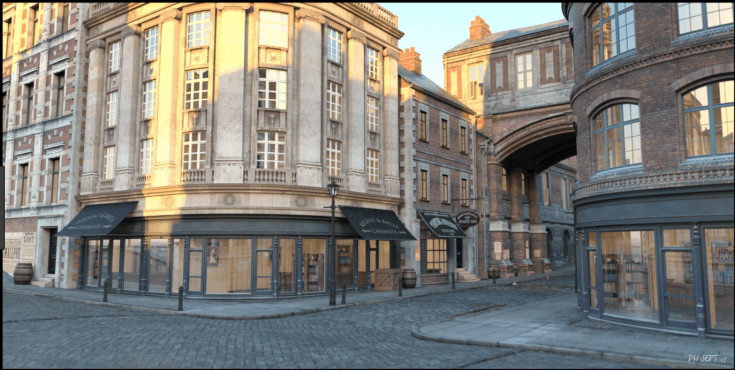
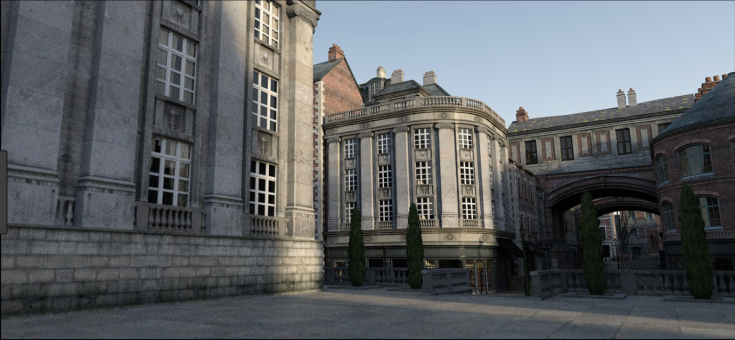
Since it’s set in the 1920s, I would think there would be some places that would have Art Deco style. Considering, the daughter in the animated film is from a wealthy household due to the farther owning a theatre, it would make sense when the daughter visits her friend who runs a pub, the pub would be a more higher class Art Deco environment. This is appropriate for the animated film.
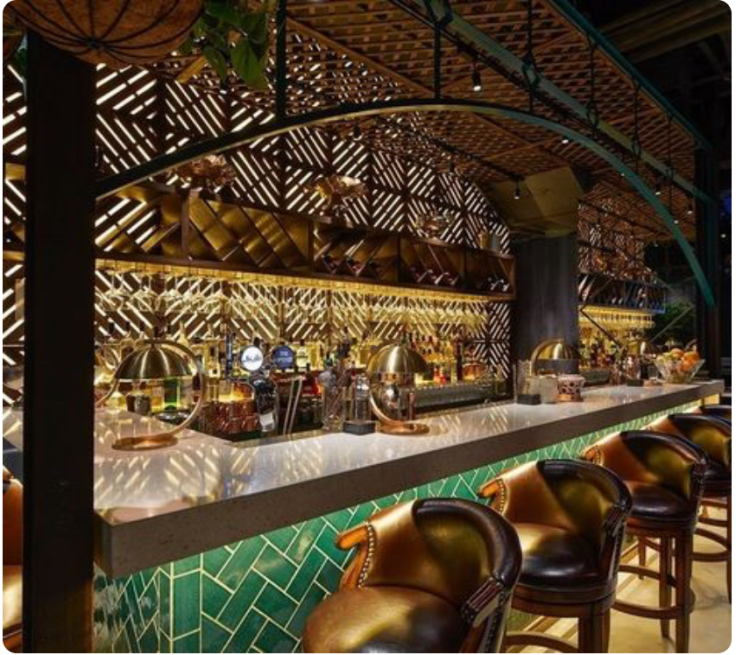
Back in 1920s Britain, there would’ve been some neoclassical buildings and interior. Theatres back then may have been quite impressive due to the neoclassical style, that is what I intend to create within the animated film. Neoclassical is a French style of architecture and décor, which comes across more upper class or quite posh.
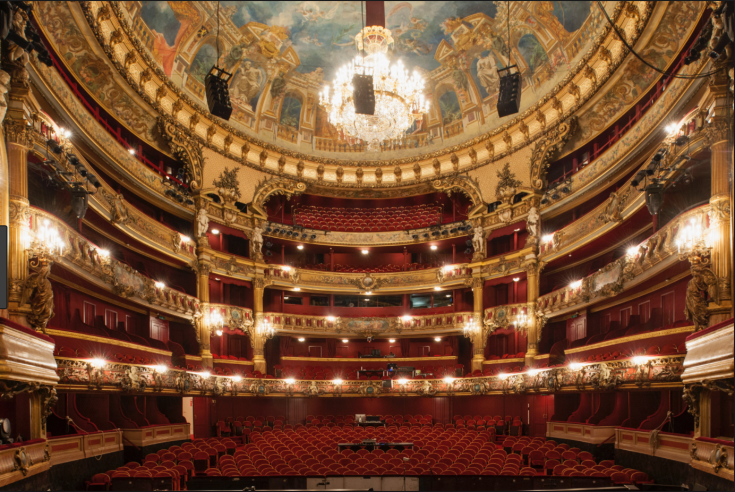
Those images what I am aiming for, but perhaps not quite as much detail but I want it to visually eye catching and impressive. These images are references to my illustrations because I want to capture the element of detail and the whole feel of old Britain or London. The reason why I chose ld Britain/London times is because fro what I imagine, its quite grey and gloom at those times, considering my film is suppose to be ambitious and adventurous in terms of following dreams that makes people happy. It would be quite a contrast to symbolise that there is a lack of creativity and joy, which is what the daughter feels at first. It also symbolises what conditions the daughter is living in, in terms of cold and grey moods between the father and the daughter.
I felt like images online isn’t enough to inspire me and get a good grasp what old British buildings were like. So I took the chance to travel to London and a few pictures. This helped me understand the common structure of each building and what sort of pattern or style they are in.
Tickets

Photos

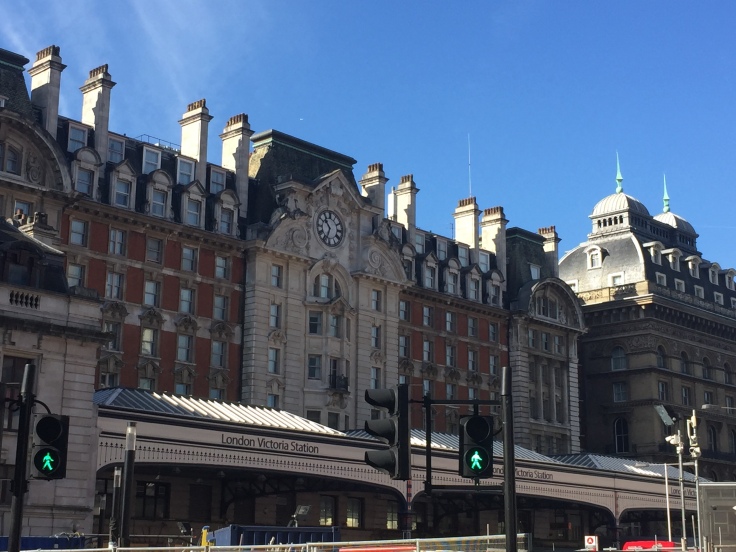
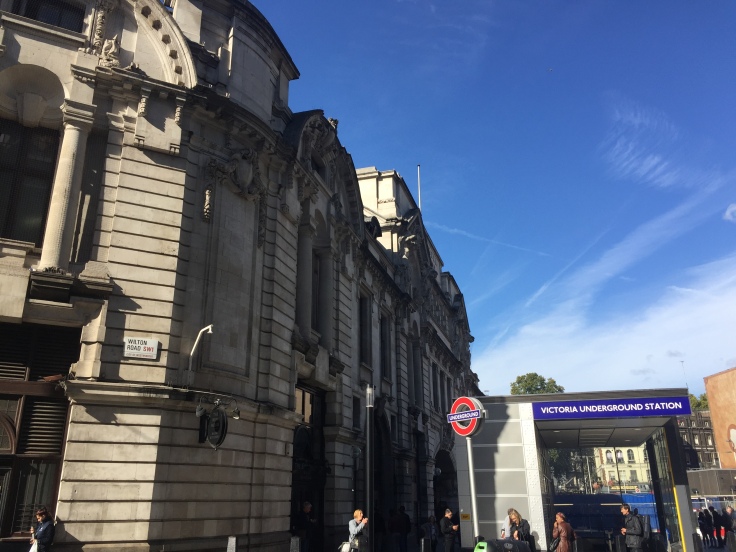
I also taken photos of old pubs and restaurants that weren’t in London, but they still have the intended look I’m going for. It gives me a different angle or perspective to look at buildings, seeing what is different between London building and not London buildings. Usually pubs have the back wood beams and white aesthetic, so they could be used as reference photos for when I am illustrating the pub scenes in my animated film. I took these photos in Yorkshire.
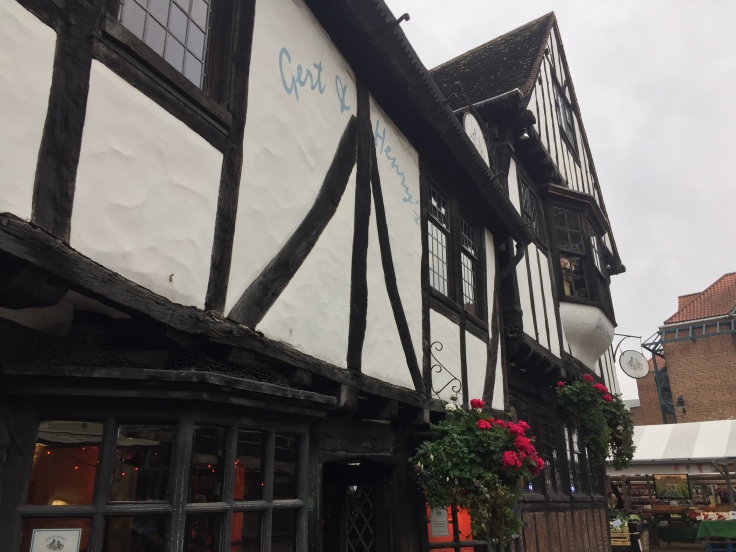
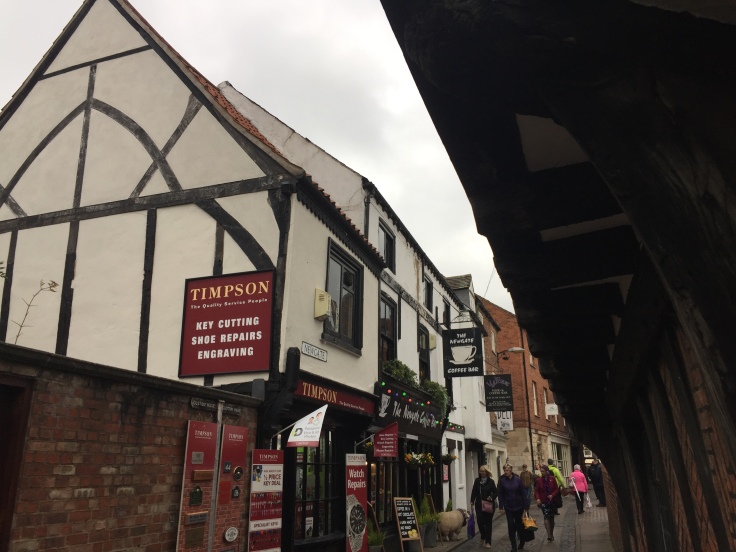
No I have a further comprehension of the style and aesthetic of British architecture. This would help my animated film be more visually correct in terms of aesthetic and feel of it all. I have found out that most buildings are quite grey and gritty because, overtime buildings do wither and get quite dirt. The sky in Britain is often cloudy and grey. I’ve noticed that brick walls have multiple different colours on them, like a bit of white, grey and dark orange. That could improve my flat coloured bricks in my illustrated buildings. Buildings has quite a lot of cracks, so I could add a bit more cracks into my background illustrations to give extra detail and texture.
Background Art:
To my understanding, animated TV shows and films, they all have their own art style. However, I have noticed that most animations have a common technique. within animations, I have noticed that backgrounds are usually more detailed and less saturated than the animated characters. Characters usually have flat colours to stand out from the background and gain the audiences attention. However, even backgrounds could be just as simple as cartoon characters in terms of the paint bucket filed colours and simplicity. For instance, The Simpsons (1989) has flat coloured backgrounds, matching the characters style and look which could indicate everything belongs together, but it may not be as appealing as cartoons with detailed backgrounds and more simple looking characters.
This image is a scene from My Neighbour Totoro (2013). This conveys the contrast between the detailed background and the animated characters. One of the main reasons as to why animated characters are not as detailed as the backgrounds, is because producers has to consider budget of the animations and the efficiency when producing the film. However, having conveying the contrast of the characters to the backgrounds could be a stylistic choice, but if not this would make attracting the audience’s attention to the subject matter a bit more easier.
This image is from the show SpongeBob SquarePants (1999). As you can see the whole thing looks quite vibrant. However, there is a difference between the style of the character and the style of the background. SpongeBob has a bit of a black outline, that is often use to separate the character from the background, to make it easier on the eyes for the audience. The background has no black outline, it has a lot of soft colours that fits with the whole style. The backgrounds in SpongeBob are quite detailed to an extent.
- Conclusion
From what I understand, backgrounds are usually more detailed than the characters. Therefore, to make my animation a bit more visually interesting, I should make my backgrounds more detailed by giving it more texture and darker tones.
Character Design:
- Female Magician Design
Considering that my animated film is set in the 1920s, I had to find images of what a magician would look like in the 1920s. There were quite a few images of magicians but I wanted to fined my ideal look of a magician. Then I stumbled upon this image of a male magician. This image is the one that inspired me to create the male magician that was auditioning in the theatre.

However, my protagonist is a female magician, considering the film is meant to be inspirational to anyone that has doubts or has been demotivated by others. Having a female as a protagonist which is playing the role of a magician would appear that no matter where abound is from or what gender, anyone has a dream to follow and achieve. Also to be quite frank, having a female protagonist is quite underrated so I decided to have a female protagonist.
I tried searching “1920s British female magicians” but not much has came up. Therefore, I proceeded to search for “female magicians” and mostly I have seen assistant female magicians but then I stumbled upon this image. This is the sort of design I was going for but it seemed a bit too modern. So what I did was combine the two images and design what the character would look like in the animated film. This was the result and I also decided to change the colour from black to dark purple. The reason being is because purple is a nice colour for the female magician and I felt like it adds a bit more of a fantasy element to the character like as if she’s full of magic and not the ordinary magician that you see in black and white.

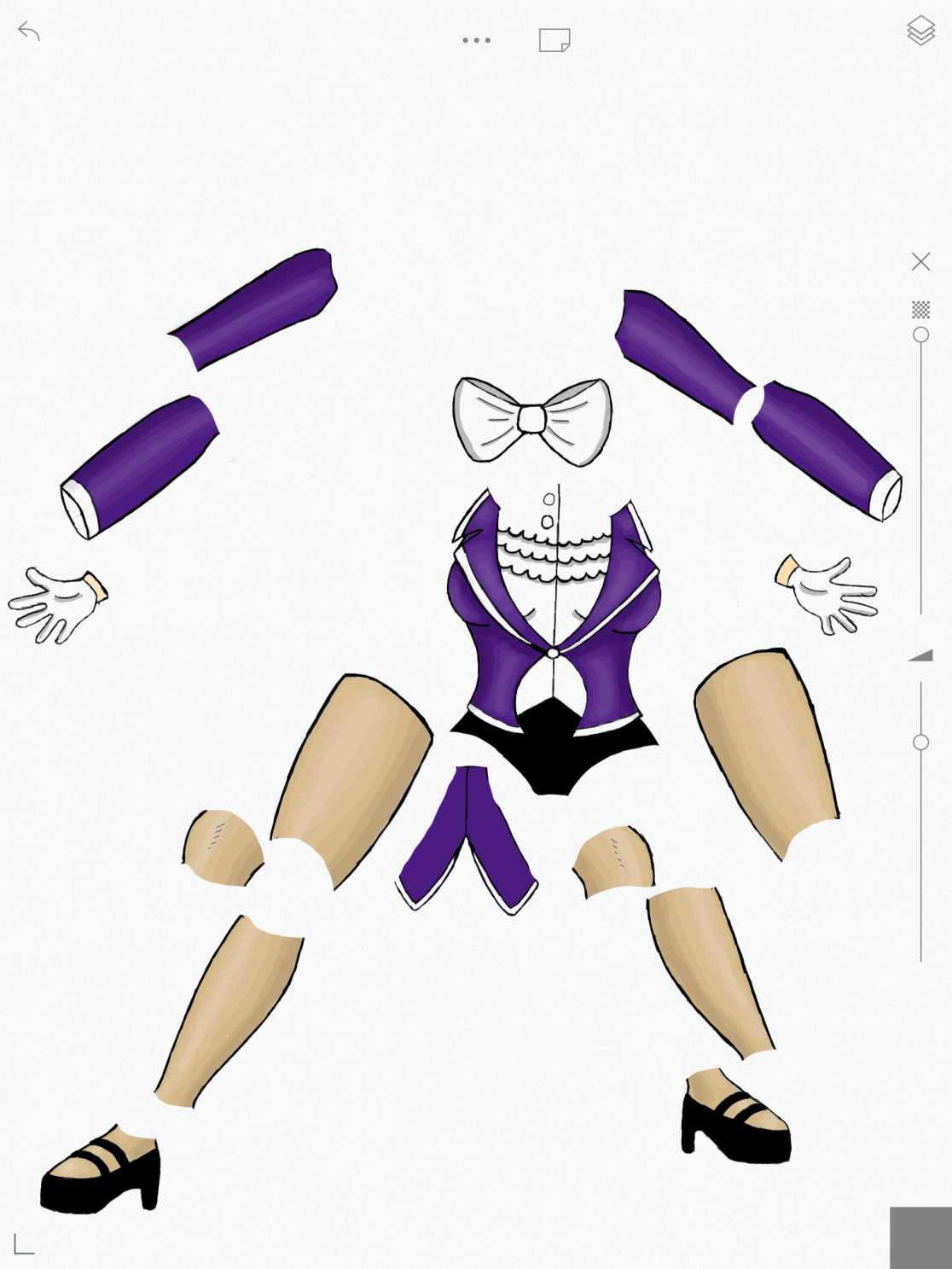
- Father Design
Then I moved onto the parent’s character design. The father of the young female magician would be the main antagonist followed by the mother being an antagonist as well. However, the regal mother is only there to complete the strict family vibe and boost the illusion of reality within the animated film. The father, I imagine him to look quite old and rich considering he owns a theatre. I want him to come across as pompous and closed minded with the way he looks and acts. I searched for “1920s rich British men” and this is what I found and chosen.



Out of all the images, I really like the blue suited man within the image of three rich men. I picked the blue one because it seemed a bit quirky to me at the time and adds a bit more colour to the character instead of having a brown or black suit.

Then I moved onto creating the father character, I made him have grey hair to indicate that he’s old and possible adds a bit more of a sourness element to the character. He has a blue suit like I intended him to have and I believe it went quite well, the blue suit seems to add a bit more colour to the film which is quite appropriate considering the film involves magic and magic can be colourful.
- Mother Design
I intend the mother to look quite posh and has a lot money by giving her a big posh dress, a big hat and a fan. The big dress and the big hat could emphasize how rich she is and that she wants people to she is. I want her to look miserable and unkind which follows the same characteristics that the father has. I searched “1920s posh dresses” and these are the images that caught my eye at the time.





Equipment:
The equipment that I will need are: my iPad, a Marantz kit, a shotgun mic and a computer to work on. iPad is to illustrate all the layers required to animate on the computer using Adobe After Effects. Marantz kit is for sound recording such as, sound effects and dialogue. The shotgun mic is the type of microphone that will be use for Foley work.
Software like Adobe after effects, Adobe Audition, Final Cut Pro.
Software:
The software that I will use is Adobe After Effects, Adobe Audition and Final Cut Pro. Adobe After Effects is to animate the illustrated layers. Adobe Audiotion will be used to mix soundtracks, sound effects and establish dialogue to the animated film. Final Cut Pro will be used to edit the completed animated clips together to make the product. There are will determine the edit pacing of each shot within the animated video.
Script Writing:
Where To My Film:
Film festivals, is a good way to present yourself to an audience and get your name out there. There’s a plethora of different festivals to choose from. It ranges from music to animation festivals. People are able to enter and could have a chance of winning awards, money or both.
It’s a place where to present your idea in front of a live audience, to inspire others and to potentially work with others. Independent distributors or maybe well known distributors, often attend film festivals. They seek new ideas and new potential to work with. Film festivals often crop-up new and exciting things for the public to see more of in the future.
- FilmFreeway
FilmFreeway is a website to search and apply for festivals such as music festivals, animation festivals and even virtual reality. This website allows us to specify what festivals we are looking for, what entry fees we would like to have and what running for years or project. This can offer festivals that a person can potentially win money. Most festivals give awards such as, editors choice or directors choice award.



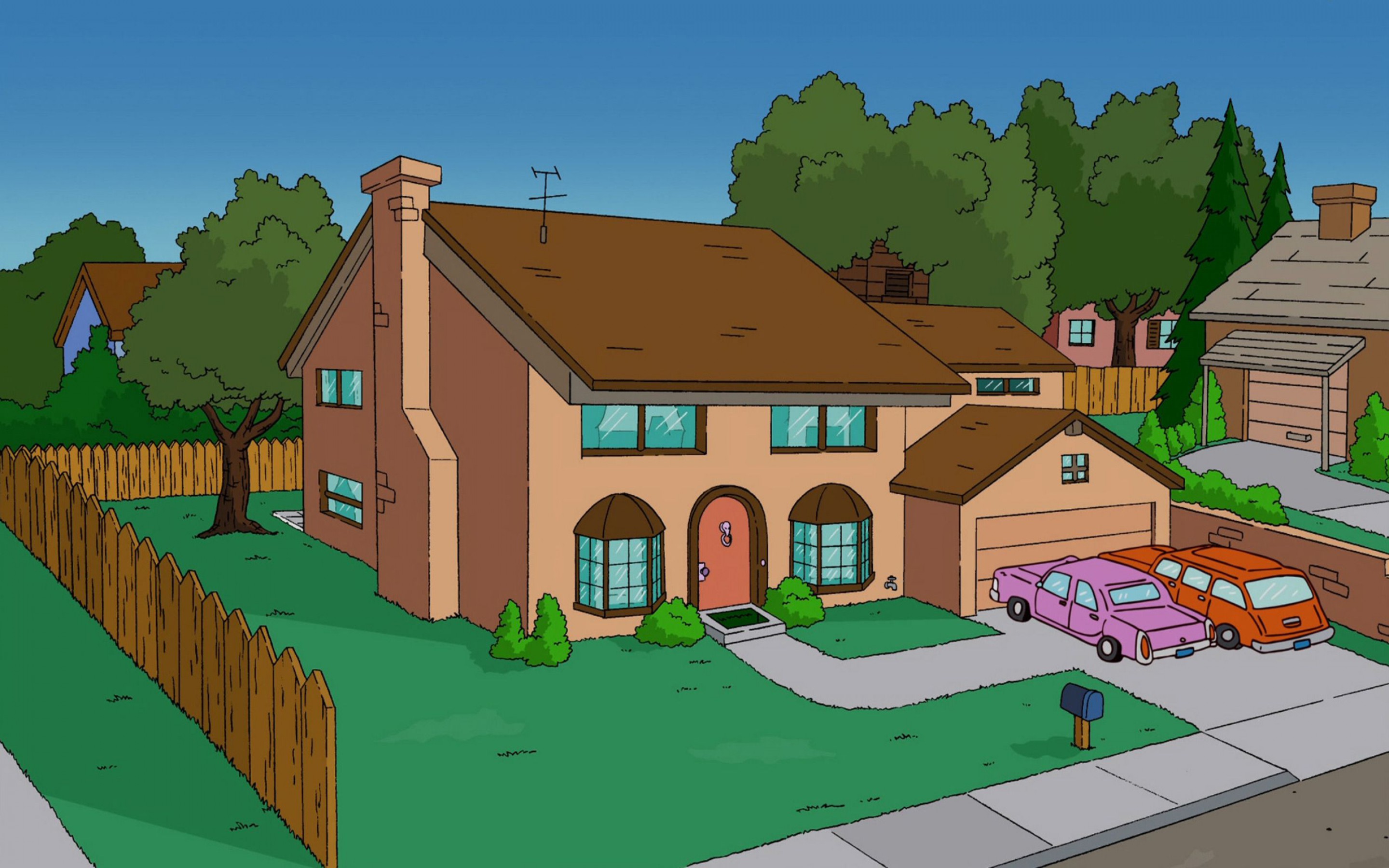
/cdn.vox-cdn.com/uploads/chorus_image/image/55049323/totoro.0.jpg)

Leave a comment